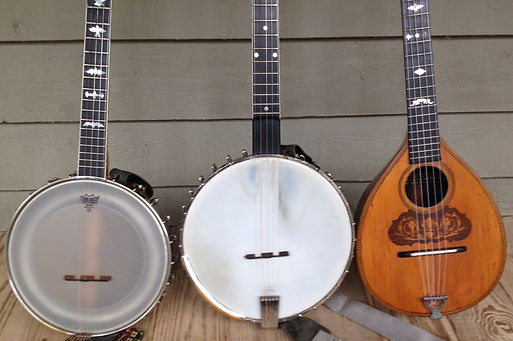Slowhand Handbook

Slowhand Banjo is based on clawhammer banjo, but it does require thinking about the banjo in new ways. Here are some instructions for those who would like to try it. I’m not a big fan of tabs which have some value for beginners, but are pretty tedious for those who work up the neck, so I’ll stick to general principles and encourage others to find songs that they both know well and love and plunge in.

Right-Hand Techniques
The typical eight-beat strum for Slowhand is a variation of the bum-pa-di-ty bum-pa-di-ty stroke of clawhammer. Here is one example
Bum: an arpeggio chord played down with the index finger.
Pa: upstroke on first string.
Dit: downstoke on any string.
Ty: thumb down on fifth string
Bum: downstroke on any string
Pa: drop thumb on any string string.
Dit: downstroke on any string
Ty: thumb down on fifth string
In fact, I rarely play a full eight-note strum because I’m trying to get away from the bumpadity bumpadity sound, so I vary it in order to play single strings, melody-bearing chords, or embellishments. One variation is the old Galax lick in which the arpeggio lasts for several beats. Another is to leave notes out or hold them for effect. Of course the old standbys of pulling-off, hammering-on, and playing triplets are handy as well. Many variations involve weaving in more chords for single notes as you progress through the song and developing elaborately picked chord progressions that suggest the melody without actually playing it. Listening hard to the song will suggest the variations the melody will bear.

Tunings
I like to use the traditional clawhammer tunings. For me, the basic ones are Double D (aDADE) and G (gDGBD).
I also use some of the other modal tunings such as the sawmill tuning (gDGCD) and Old G (gDGDE), but with these I leave many open strings in the chords to retain some of the modal feel of these tunes.

Left-hand Technique
The way I learned the chords up the neck was to make a chart of the keyboard in each tuning and plot out all of the notes on it. Then I created configurtions of the chord patterns for each common chord in the key going up the neck. I just made these by hand. I found that the process of making the chart helped me learn the chords in each tuning. Once I had the chart down, I would practice strumming the chords in each position until I could move with ease between each chord. These charts are pretty beat up and coffee stained, but I'll reprint them anyway to give you an idea. I urge you to create your own.
Chords in G-tuning

Chords in D-tuning
